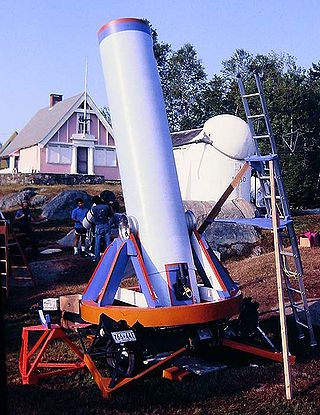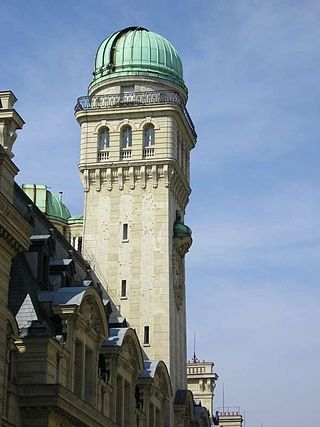
Amateur telescope making is the activity of building telescopes as a hobby, as opposed to being a paid professional. Amateur telescope makers build their instruments for personal enjoyment of a technical challenge, as a way to obtain an inexpensive or personally customized telescope, or as a research tool in the field of astronomy. Amateur telescope makers are usually a sub-group in the field of amateur astronomy.

Jean Bernard Léon Foucault was a French physicist best known for his demonstration of the Foucault pendulum, a device demonstrating the effect of Earth's rotation. He also made an early measurement of the speed of light, discovered eddy currents, and is credited with naming the gyroscope.

The Paris Observatory, a research institution of the Paris Sciences et Lettres University, is the foremost astronomical observatory of France, and one of the largest astronomical centers in the world. Its historic building is on the Left Bank of the Seine in central Paris, but most of the staff work on a satellite campus in Meudon, a suburb southwest of Paris.
T. Cooke & Sons was an English instrument-making firm, headquartered in York. It was founded by Thomas Cooke by 1837.

Markree Observatory was an astronomical observatory in County Sligo, Ireland. The asteroid 9 Metis was discovered from this observatory in 1848 by Cooper's assistant Andrew Graham using a comet seeker telescope. The observatory was also home to the largest refractor of the early 1830s, which had a 13.3-inch (340 mm) aperture Cauchoix of Paris lens; the largest in the world at that time. The observatory also housed a number of instruments and was operated to varying degrees throughout the 19th century.

The Kodaikanal Solar Observatory is a solar observatory owned and operated by the Indian Institute of Astrophysics. It is on the southern tip of the Palani Hills 4 kilometres (2.5 mi) from Kodaikanal.

Marseille Observatory is an astronomical observatory located in Marseille, France, with a history that goes back to the early 18th century. In its 1877 incarnation, it was the discovery site of a group of galaxies known as Stephan's Quintet, discovered by its director Édouard Stephan. Marseille Observatory is now run as a joint research unit by Aix-Marseille University and the French National Center for Scientific Research (CNRS).

The Royal Observatory of Belgium has been situated in the Uccle municipality of Brussels since 1890.

Grubb Parsons was a historic manufacturer of telescopes, active in the 19th and 20th centuries. They built numerous large research telescopes, including several that were the largest in the world of their type.

The Great Paris Exhibition Telescope of 1900, with an objective lens of 1.25 m (49 in) in diameter, was the largest refracting telescope ever constructed. It was built as the centerpiece of the Paris Universal Exhibition of 1900. Its construction was instigated in 1892 by François Deloncle (1856–1922), a member of the French Chambre des Députés. Since it was built for exhibit purposes within a large metropolis, and its design made it difficult to aim at astronomical objects, it was not suited for scientific use. When the year-long exposition was over, its builders were unable to sell it. It was ultimately broken up for scrap; the lenses are still stored away at the Paris Observatory.

John Browning was an English inventor and manufacturer of precision scientific instruments in the 19th and early 20th centuries. He hailed from a long line of English instrument makers and transformed the family business from one dealing in nautical instruments to one specialising in scientific instruments. Browning was particularly well known for his advances in the fields of spectroscopy, astronomy, and optometry.

Noël Marie Paymal Lerebours was a French optician and daguerreotypist. He is best known today for his Excursions Daguerriennes, books of views of the world's monuments, based on early photographs redrawn by hand as Aquatint engravings.

The Royal Observatory, Cape of Good Hope, is a former scientific institution in South Africa. Founded by the British Board of Longitude in 1820, its main building is now the headquarters building of the South African Astronomical Observatory.

The Compagnie française des métaux (CFM) was a French metallurgy company founded in 1892 that acquired the assets of a predecessor that had gone into liquidation. The company operated a number of plants in different locations in France, mainly making copper and aluminum products. In 1962 it was merged with Tréfileries et Laminoirs du Havre to form Tréfimétaux.

The Astronomy Tower of the Sorbonne is a tower at the Sorbonne University's Paris campus built to house an astronomical observatory for its students. The structure was erected during the reconstruction of the Sorbonne, between 1885 and 1901. The tower is 39 meters high, has an upper and lower dome, and includes several rooms. The upper dome houses the telescope, and the lower dome contains an optics workshop for amateurs to make mirrors. The tower is operated by the Société astronomique de France and is available for tours and amateur observations.
Denis Albert Bardou was a French manufacturer of precision optical instruments.
Raymond Augustin Jean-Baptiste Mailhat was a French manufacturer of telescopes and precision optical instruments.

The Observatory of the rue Serpente was an astronomical observatory owned and operated by the Société Astronomique de France in the historic Latin Quarter of Paris. It operated between 1890 until 1968, when it was transferred to a new location at the nearby Astronomy Tower of the Sorbonne.

Paul Ferdinand Gautier was a French scientific instrument maker who specialized in precision astronomical telescopes and measuring equipment. He produced instruments for many participants of the 1887 Carte du Ciel project.

The Napoleon III Telescope is an historic 6-inch refracting telescope owned by the University of Notre Dame. The telescope was given to the university in 1867 by French Emperor Napoleon III and is housed in an observatory on the top of the Nieuwland Hall of Science. The objective lens of the telescope was designed by the French physicist Léon Foucault who is best known for a pendulum experiment that demonstrated earth's rotation.

















